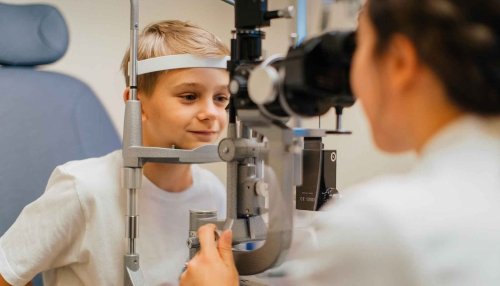What Every Parent Should Know About Children’s Vision
Healthy eyes are a critical component to a child’s development. Vision is a fundamental sense that may affect visual and brain development, learning and school performance, communication, and visual processing abilities.

Your child’s early learning environment is primarily through visual input, particularly in the classroom. The importance of timely and regular eye exams sets the stage for your child’s optimum eye health and visual success.
Below are answers to the most common questions that parents have about their children’s vision.
What conditions most frequently affect a child’s vision?
The conditions most frequently affecting a child’s vision are uncorrected refractive error, amblyopia, and strabismus. Uncorrected refractive error may include near/farsightedness and astigmatism. Amblyopia, commonly known as a lazy eye, occurs when one eye has better vision than the other. Strabismus is the condition in which in one eye is misaligned or turned. These conditions can be addressed and treated during your child’s routine eye examination. If not adequately corrected, they may cause significant vision loss, affecting both the quality of vision and your child’s overall development and learning.
When should I schedule my child’s first eye examination?
It may surprise you to know that a child’s first eye examination is recommended at six months of age by the American Optometric Association (AOA). If your child has no family history or personal risk factors – which can include pre-term birth, an eye turn, or lack of interest in following objects – other exams are recommended at the age of three and again prior to starting school. InfantSEE® is an AOA program providing free eye examinations to children under the age of one. As early as six months, your child’s visual acuity, eye alignment, refractive error, and ocular health are checked to help ensure a strong foundation for development. Check with your local eye doctors to find out if they are participating InfantSEE providers.
Aren’t vision screenings as good as an annual eye examination?
Vision screenings within schools and the pediatrician’s office are helpful in identifying children at risk, but are not equivalent to a comprehensive eye exam by an eye care provider. Many children may pass a vision screening, but still exhibit conditions including farsightedness, strabismus, double vision, and ocular health issues. Additionally, vision screenings do not typically include binocular vision testing to evaluate how the eyes track, focus on near objects, and work together as a team.
What should I expect at my child’s eye exam?
During your visit, your eye doctor will check your child’s visual acuity with an eye chart based on age. Eye alignment and refractive error will all be evaluated with basic instruments. The doctor will use eye drops to dilate the pupils to check the health of the back of the eyes and further assess if your child needs glasses. If your child is school-age, the doctor may perform a more detailed examination to review the eyes’ ability to focus and make appropriate movements during reading.
My child has no vision complaints; do we still need to see an eye doctor?
Healthy eyes and vision are a critical component of development. A child may have perfect 20/20 vision, and still have visual deficits affecting learning and school performance. These deficits may include double vision, poor eye teaming or tracking, poor ability to focus, and disruptions in visual processing. Additionally, many children who have decreased or double vision do not know that the world should look any different, and therefore are unlikely to report this to a parent or teacher.
What symptoms should I look for?
The following are signs and symptoms that your child may be experiencing a vision problem:
- Squinting
- Tilting or turning the head to view an object
- Eye misalignment (strabismus)
- Complaining of headaches when doing visual tasks
- Inability to see things that are far or near
- Trouble concentrating or fatigue in school
- Avoidance of close-up work
- Reporting that words move on the page
- Consistently losing his or her place while reading, or re-reading the same lines
- Covering an eye
Be sure to schedule an eye examination for your child with an optometrist between the ages of six and twelve months, and at least annually. It’s also good to schedule an exam whenever you have any concerns about your child’s vision or if she or he seems to have any learning difficulty in school.
The information contained in this article is not intended to be a substitute for professional medical advice, diagnosis, care, or treatment. Always consult your physician or other qualified healthcare provider with any questions regarding any possible medical condition.
Kelly Meehan, O.D., FAAO, Arizona College of Optometry.



